NUR2101 Written Assessment: Chronic Illness & Patient Care
VerifiedAdded on 2023/06/18
|11
|2726
|385
Report
AI Summary
This report presents a comprehensive assessment of a patient case, focusing on chronic conditions, specifically Type 1 Diabetes and Gastroenteritis. It delves into the pathophysiology, symptoms, and relevant diagnostic tests associated with these conditions. The report analyzes potential complications of the chronic diseases and outlines essential psychosocial, cultural, and health literacy considerations for the patient. Nursing management priorities are evaluated, including pharmacological and non-pharmacological interventions, as well as self-management strategies. Furthermore, the report includes the development of a patient information resource, providing essential information about Type 1 Diabetes, its symptoms, management, and potential complications. This resource aims to educate patients and empower them to actively participate in their care plan. Desklib offers a wealth of similar solved assignments and past papers for students seeking further assistance.
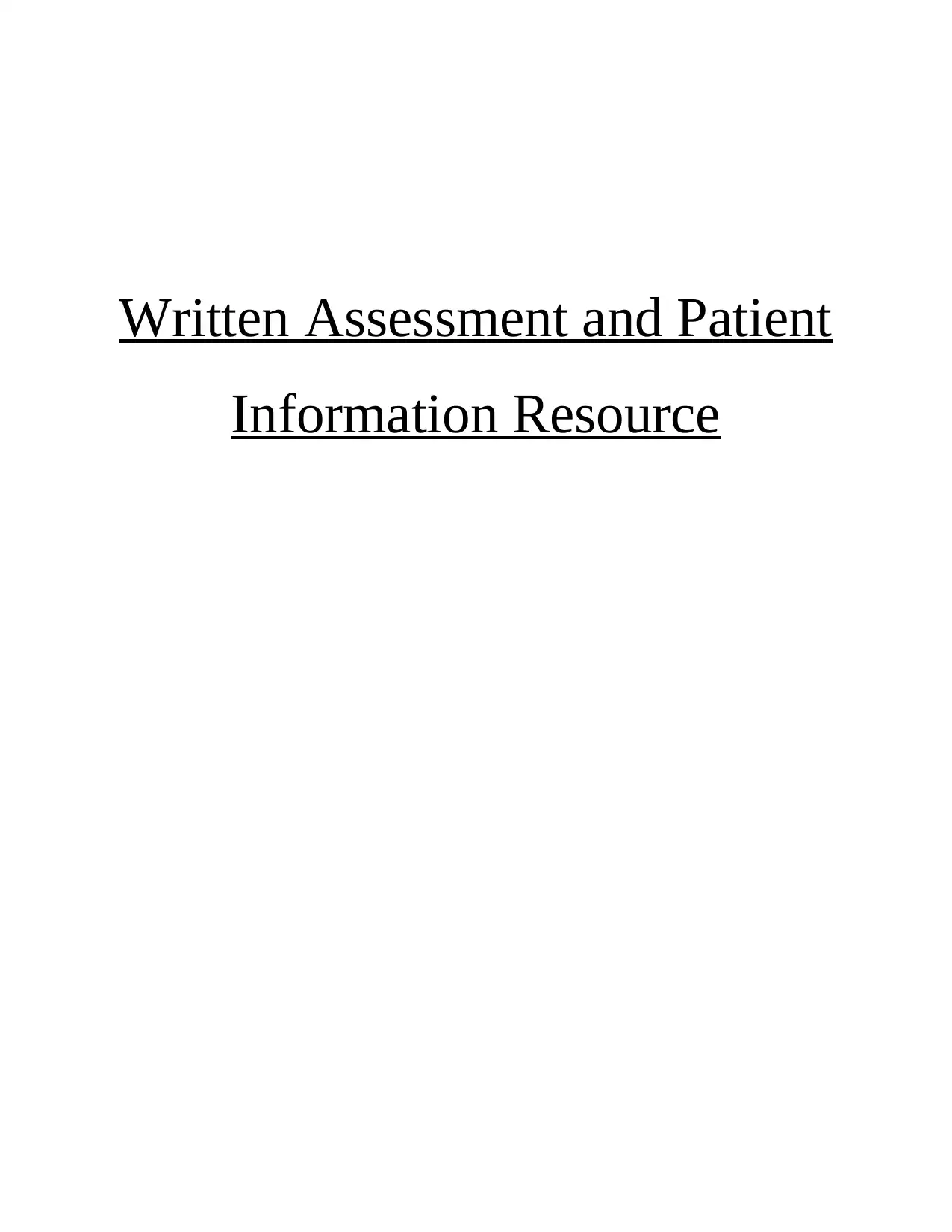
Written Assessment and Patient
Information Resource
Information Resource
Paraphrase This Document
Need a fresh take? Get an instant paraphrase of this document with our AI Paraphraser
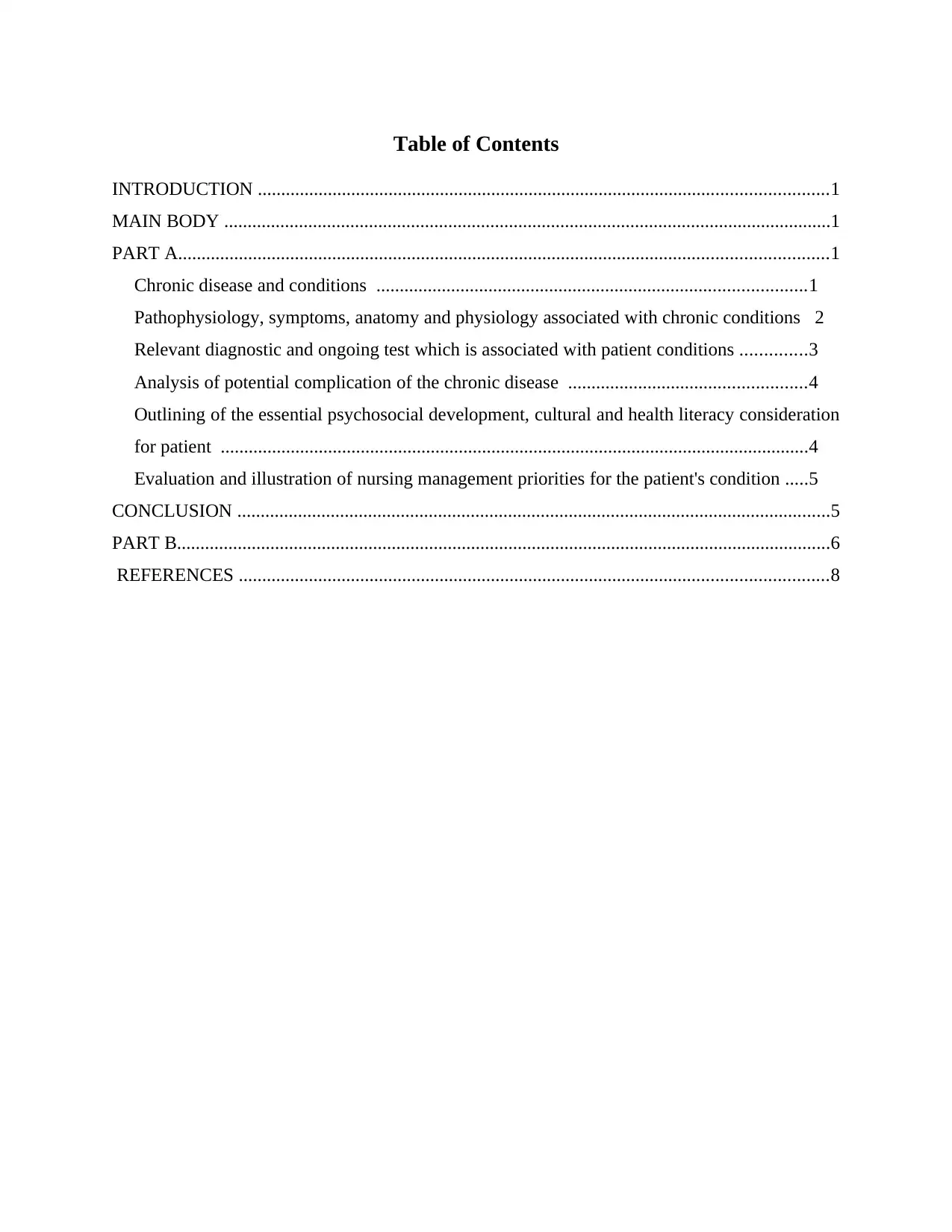
Table of Contents
INTRODUCTION ..........................................................................................................................1
MAIN BODY ..................................................................................................................................1
PART A...........................................................................................................................................1
Chronic disease and conditions ............................................................................................1
Pathophysiology, symptoms, anatomy and physiology associated with chronic conditions 2
Relevant diagnostic and ongoing test which is associated with patient conditions ..............3
Analysis of potential complication of the chronic disease ...................................................4
Outlining of the essential psychosocial development, cultural and health literacy consideration
for patient ..............................................................................................................................4
Evaluation and illustration of nursing management priorities for the patient's condition .....5
CONCLUSION ...............................................................................................................................5
PART B............................................................................................................................................6
REFERENCES ..............................................................................................................................8
INTRODUCTION ..........................................................................................................................1
MAIN BODY ..................................................................................................................................1
PART A...........................................................................................................................................1
Chronic disease and conditions ............................................................................................1
Pathophysiology, symptoms, anatomy and physiology associated with chronic conditions 2
Relevant diagnostic and ongoing test which is associated with patient conditions ..............3
Analysis of potential complication of the chronic disease ...................................................4
Outlining of the essential psychosocial development, cultural and health literacy consideration
for patient ..............................................................................................................................4
Evaluation and illustration of nursing management priorities for the patient's condition .....5
CONCLUSION ...............................................................................................................................5
PART B............................................................................................................................................6
REFERENCES ..............................................................................................................................8
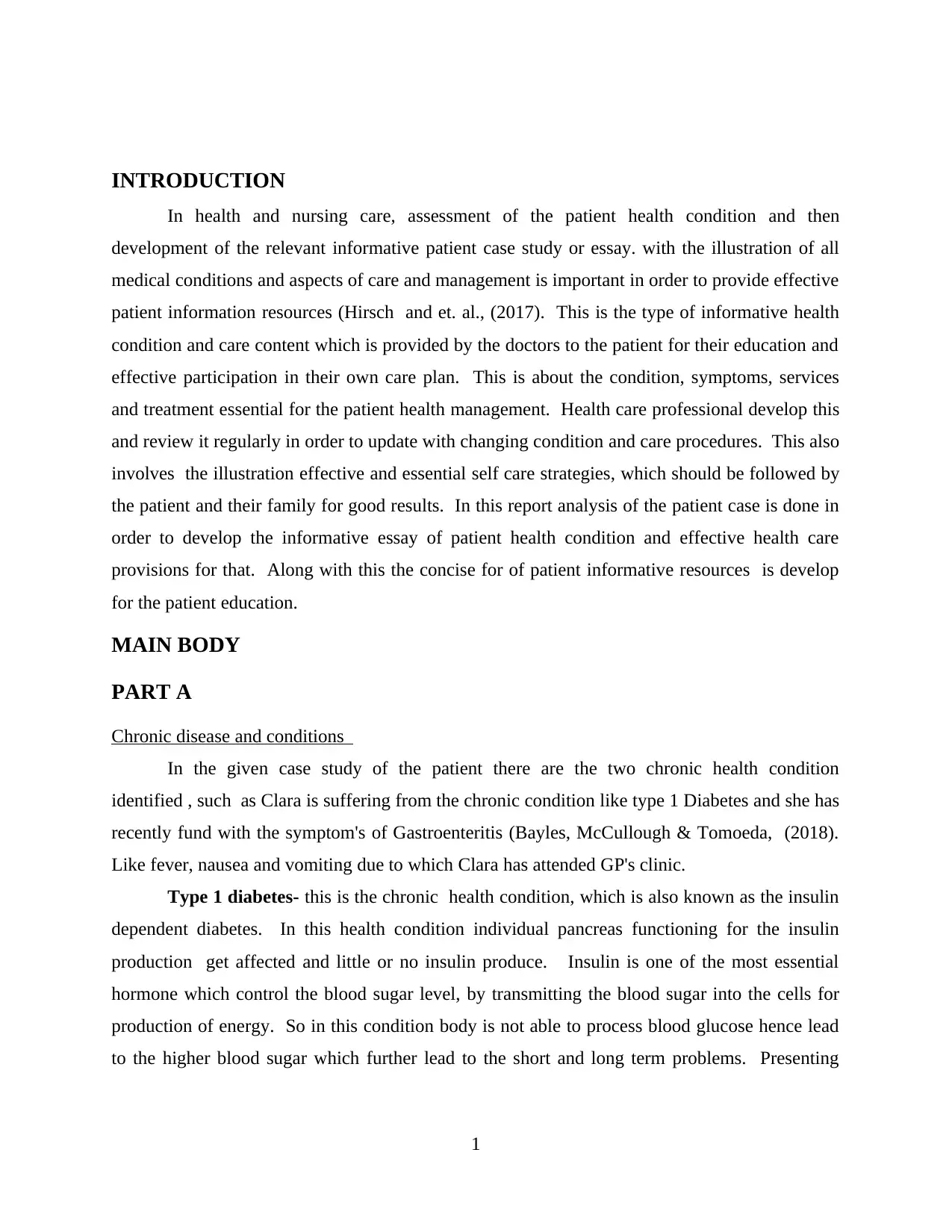
INTRODUCTION
In health and nursing care, assessment of the patient health condition and then
development of the relevant informative patient case study or essay. with the illustration of all
medical conditions and aspects of care and management is important in order to provide effective
patient information resources (Hirsch and et. al., (2017). This is the type of informative health
condition and care content which is provided by the doctors to the patient for their education and
effective participation in their own care plan. This is about the condition, symptoms, services
and treatment essential for the patient health management. Health care professional develop this
and review it regularly in order to update with changing condition and care procedures. This also
involves the illustration effective and essential self care strategies, which should be followed by
the patient and their family for good results. In this report analysis of the patient case is done in
order to develop the informative essay of patient health condition and effective health care
provisions for that. Along with this the concise for of patient informative resources is develop
for the patient education.
MAIN BODY
PART A
Chronic disease and conditions
In the given case study of the patient there are the two chronic health condition
identified , such as Clara is suffering from the chronic condition like type 1 Diabetes and she has
recently fund with the symptom's of Gastroenteritis (Bayles, McCullough & Tomoeda, (2018).
Like fever, nausea and vomiting due to which Clara has attended GP's clinic.
Type 1 diabetes- this is the chronic health condition, which is also known as the insulin
dependent diabetes. In this health condition individual pancreas functioning for the insulin
production get affected and little or no insulin produce. Insulin is one of the most essential
hormone which control the blood sugar level, by transmitting the blood sugar into the cells for
production of energy. So in this condition body is not able to process blood glucose hence lead
to the higher blood sugar which further lead to the short and long term problems. Presenting
1
In health and nursing care, assessment of the patient health condition and then
development of the relevant informative patient case study or essay. with the illustration of all
medical conditions and aspects of care and management is important in order to provide effective
patient information resources (Hirsch and et. al., (2017). This is the type of informative health
condition and care content which is provided by the doctors to the patient for their education and
effective participation in their own care plan. This is about the condition, symptoms, services
and treatment essential for the patient health management. Health care professional develop this
and review it regularly in order to update with changing condition and care procedures. This also
involves the illustration effective and essential self care strategies, which should be followed by
the patient and their family for good results. In this report analysis of the patient case is done in
order to develop the informative essay of patient health condition and effective health care
provisions for that. Along with this the concise for of patient informative resources is develop
for the patient education.
MAIN BODY
PART A
Chronic disease and conditions
In the given case study of the patient there are the two chronic health condition
identified , such as Clara is suffering from the chronic condition like type 1 Diabetes and she has
recently fund with the symptom's of Gastroenteritis (Bayles, McCullough & Tomoeda, (2018).
Like fever, nausea and vomiting due to which Clara has attended GP's clinic.
Type 1 diabetes- this is the chronic health condition, which is also known as the insulin
dependent diabetes. In this health condition individual pancreas functioning for the insulin
production get affected and little or no insulin produce. Insulin is one of the most essential
hormone which control the blood sugar level, by transmitting the blood sugar into the cells for
production of energy. So in this condition body is not able to process blood glucose hence lead
to the higher blood sugar which further lead to the short and long term problems. Presenting
1
⊘ This is a preview!⊘
Do you want full access?
Subscribe today to unlock all pages.

Trusted by 1+ million students worldwide
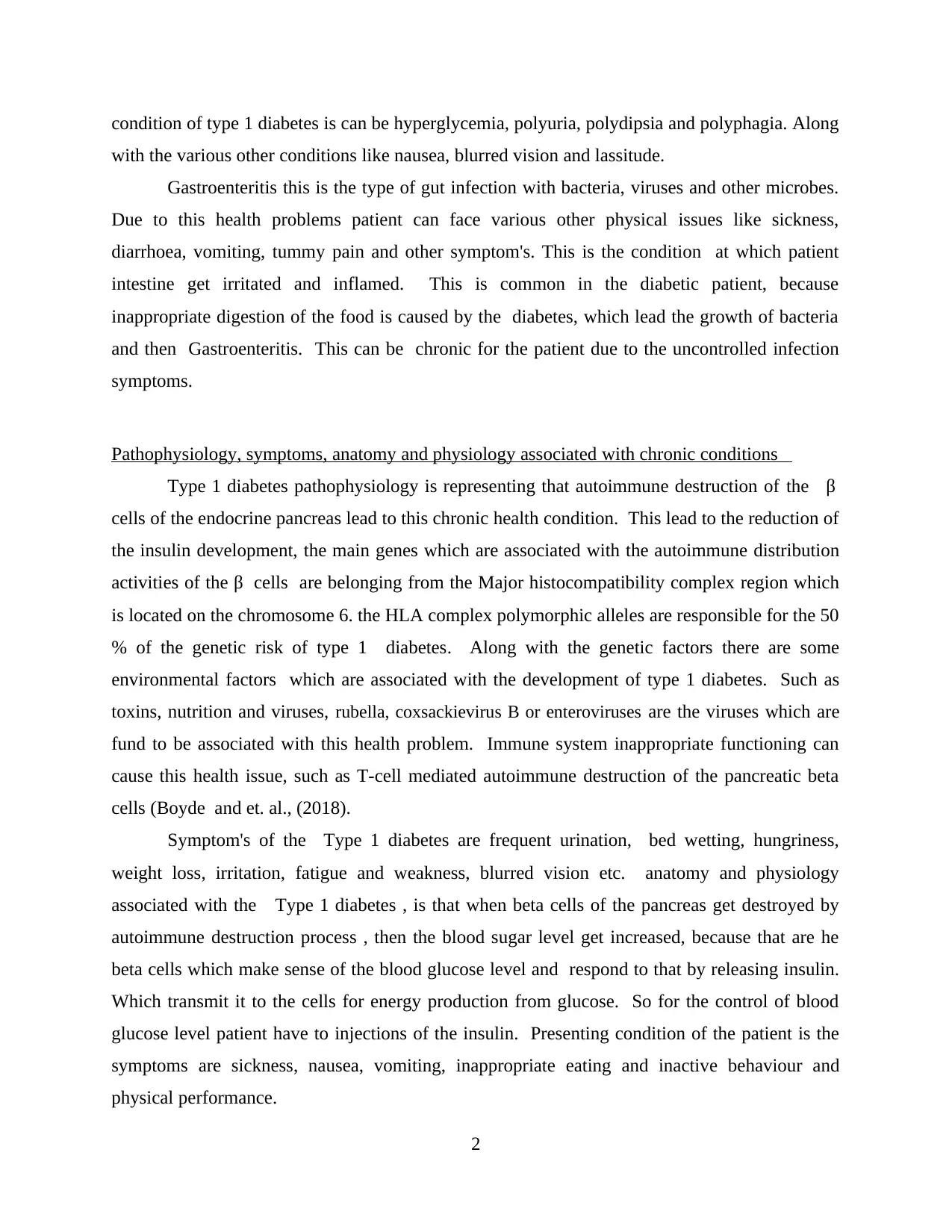
condition of type 1 diabetes is can be hyperglycemia, polyuria, polydipsia and polyphagia. Along
with the various other conditions like nausea, blurred vision and lassitude.
Gastroenteritis this is the type of gut infection with bacteria, viruses and other microbes.
Due to this health problems patient can face various other physical issues like sickness,
diarrhoea, vomiting, tummy pain and other symptom's. This is the condition at which patient
intestine get irritated and inflamed. This is common in the diabetic patient, because
inappropriate digestion of the food is caused by the diabetes, which lead the growth of bacteria
and then Gastroenteritis. This can be chronic for the patient due to the uncontrolled infection
symptoms.
Pathophysiology, symptoms, anatomy and physiology associated with chronic conditions
Type 1 diabetes pathophysiology is representing that autoimmune destruction of the β
cells of the endocrine pancreas lead to this chronic health condition. This lead to the reduction of
the insulin development, the main genes which are associated with the autoimmune distribution
activities of the β cells are belonging from the Major histocompatibility complex region which
is located on the chromosome 6. the HLA complex polymorphic alleles are responsible for the 50
% of the genetic risk of type 1 diabetes. Along with the genetic factors there are some
environmental factors which are associated with the development of type 1 diabetes. Such as
toxins, nutrition and viruses, rubella, coxsackievirus B or enteroviruses are the viruses which are
fund to be associated with this health problem. Immune system inappropriate functioning can
cause this health issue, such as T-cell mediated autoimmune destruction of the pancreatic beta
cells (Boyde and et. al., (2018).
Symptom's of the Type 1 diabetes are frequent urination, bed wetting, hungriness,
weight loss, irritation, fatigue and weakness, blurred vision etc. anatomy and physiology
associated with the Type 1 diabetes , is that when beta cells of the pancreas get destroyed by
autoimmune destruction process , then the blood sugar level get increased, because that are he
beta cells which make sense of the blood glucose level and respond to that by releasing insulin.
Which transmit it to the cells for energy production from glucose. So for the control of blood
glucose level patient have to injections of the insulin. Presenting condition of the patient is the
symptoms are sickness, nausea, vomiting, inappropriate eating and inactive behaviour and
physical performance.
2
with the various other conditions like nausea, blurred vision and lassitude.
Gastroenteritis this is the type of gut infection with bacteria, viruses and other microbes.
Due to this health problems patient can face various other physical issues like sickness,
diarrhoea, vomiting, tummy pain and other symptom's. This is the condition at which patient
intestine get irritated and inflamed. This is common in the diabetic patient, because
inappropriate digestion of the food is caused by the diabetes, which lead the growth of bacteria
and then Gastroenteritis. This can be chronic for the patient due to the uncontrolled infection
symptoms.
Pathophysiology, symptoms, anatomy and physiology associated with chronic conditions
Type 1 diabetes pathophysiology is representing that autoimmune destruction of the β
cells of the endocrine pancreas lead to this chronic health condition. This lead to the reduction of
the insulin development, the main genes which are associated with the autoimmune distribution
activities of the β cells are belonging from the Major histocompatibility complex region which
is located on the chromosome 6. the HLA complex polymorphic alleles are responsible for the 50
% of the genetic risk of type 1 diabetes. Along with the genetic factors there are some
environmental factors which are associated with the development of type 1 diabetes. Such as
toxins, nutrition and viruses, rubella, coxsackievirus B or enteroviruses are the viruses which are
fund to be associated with this health problem. Immune system inappropriate functioning can
cause this health issue, such as T-cell mediated autoimmune destruction of the pancreatic beta
cells (Boyde and et. al., (2018).
Symptom's of the Type 1 diabetes are frequent urination, bed wetting, hungriness,
weight loss, irritation, fatigue and weakness, blurred vision etc. anatomy and physiology
associated with the Type 1 diabetes , is that when beta cells of the pancreas get destroyed by
autoimmune destruction process , then the blood sugar level get increased, because that are he
beta cells which make sense of the blood glucose level and respond to that by releasing insulin.
Which transmit it to the cells for energy production from glucose. So for the control of blood
glucose level patient have to injections of the insulin. Presenting condition of the patient is the
symptoms are sickness, nausea, vomiting, inappropriate eating and inactive behaviour and
physical performance.
2
Paraphrase This Document
Need a fresh take? Get an instant paraphrase of this document with our AI Paraphraser
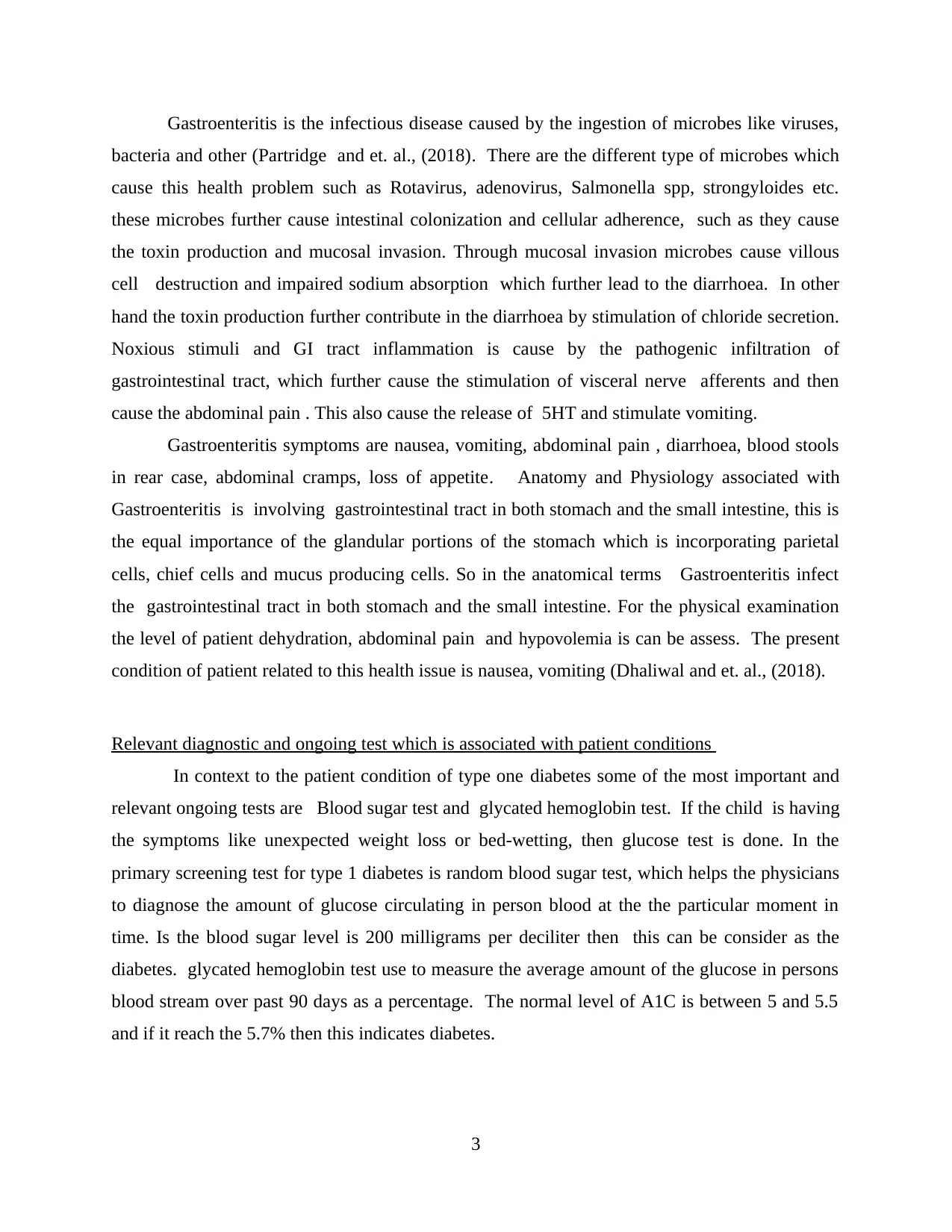
Gastroenteritis is the infectious disease caused by the ingestion of microbes like viruses,
bacteria and other (Partridge and et. al., (2018). There are the different type of microbes which
cause this health problem such as Rotavirus, adenovirus, Salmonella spp, strongyloides etc.
these microbes further cause intestinal colonization and cellular adherence, such as they cause
the toxin production and mucosal invasion. Through mucosal invasion microbes cause villous
cell destruction and impaired sodium absorption which further lead to the diarrhoea. In other
hand the toxin production further contribute in the diarrhoea by stimulation of chloride secretion.
Noxious stimuli and GI tract inflammation is cause by the pathogenic infiltration of
gastrointestinal tract, which further cause the stimulation of visceral nerve afferents and then
cause the abdominal pain . This also cause the release of 5HT and stimulate vomiting.
Gastroenteritis symptoms are nausea, vomiting, abdominal pain , diarrhoea, blood stools
in rear case, abdominal cramps, loss of appetite. Anatomy and Physiology associated with
Gastroenteritis is involving gastrointestinal tract in both stomach and the small intestine, this is
the equal importance of the glandular portions of the stomach which is incorporating parietal
cells, chief cells and mucus producing cells. So in the anatomical terms Gastroenteritis infect
the gastrointestinal tract in both stomach and the small intestine. For the physical examination
the level of patient dehydration, abdominal pain and hypovolemia is can be assess. The present
condition of patient related to this health issue is nausea, vomiting (Dhaliwal and et. al., (2018).
Relevant diagnostic and ongoing test which is associated with patient conditions
In context to the patient condition of type one diabetes some of the most important and
relevant ongoing tests are Blood sugar test and glycated hemoglobin test. If the child is having
the symptoms like unexpected weight loss or bed-wetting, then glucose test is done. In the
primary screening test for type 1 diabetes is random blood sugar test, which helps the physicians
to diagnose the amount of glucose circulating in person blood at the the particular moment in
time. Is the blood sugar level is 200 milligrams per deciliter then this can be consider as the
diabetes. glycated hemoglobin test use to measure the average amount of the glucose in persons
blood stream over past 90 days as a percentage. The normal level of A1C is between 5 and 5.5
and if it reach the 5.7% then this indicates diabetes.
3
bacteria and other (Partridge and et. al., (2018). There are the different type of microbes which
cause this health problem such as Rotavirus, adenovirus, Salmonella spp, strongyloides etc.
these microbes further cause intestinal colonization and cellular adherence, such as they cause
the toxin production and mucosal invasion. Through mucosal invasion microbes cause villous
cell destruction and impaired sodium absorption which further lead to the diarrhoea. In other
hand the toxin production further contribute in the diarrhoea by stimulation of chloride secretion.
Noxious stimuli and GI tract inflammation is cause by the pathogenic infiltration of
gastrointestinal tract, which further cause the stimulation of visceral nerve afferents and then
cause the abdominal pain . This also cause the release of 5HT and stimulate vomiting.
Gastroenteritis symptoms are nausea, vomiting, abdominal pain , diarrhoea, blood stools
in rear case, abdominal cramps, loss of appetite. Anatomy and Physiology associated with
Gastroenteritis is involving gastrointestinal tract in both stomach and the small intestine, this is
the equal importance of the glandular portions of the stomach which is incorporating parietal
cells, chief cells and mucus producing cells. So in the anatomical terms Gastroenteritis infect
the gastrointestinal tract in both stomach and the small intestine. For the physical examination
the level of patient dehydration, abdominal pain and hypovolemia is can be assess. The present
condition of patient related to this health issue is nausea, vomiting (Dhaliwal and et. al., (2018).
Relevant diagnostic and ongoing test which is associated with patient conditions
In context to the patient condition of type one diabetes some of the most important and
relevant ongoing tests are Blood sugar test and glycated hemoglobin test. If the child is having
the symptoms like unexpected weight loss or bed-wetting, then glucose test is done. In the
primary screening test for type 1 diabetes is random blood sugar test, which helps the physicians
to diagnose the amount of glucose circulating in person blood at the the particular moment in
time. Is the blood sugar level is 200 milligrams per deciliter then this can be consider as the
diabetes. glycated hemoglobin test use to measure the average amount of the glucose in persons
blood stream over past 90 days as a percentage. The normal level of A1C is between 5 and 5.5
and if it reach the 5.7% then this indicates diabetes.
3
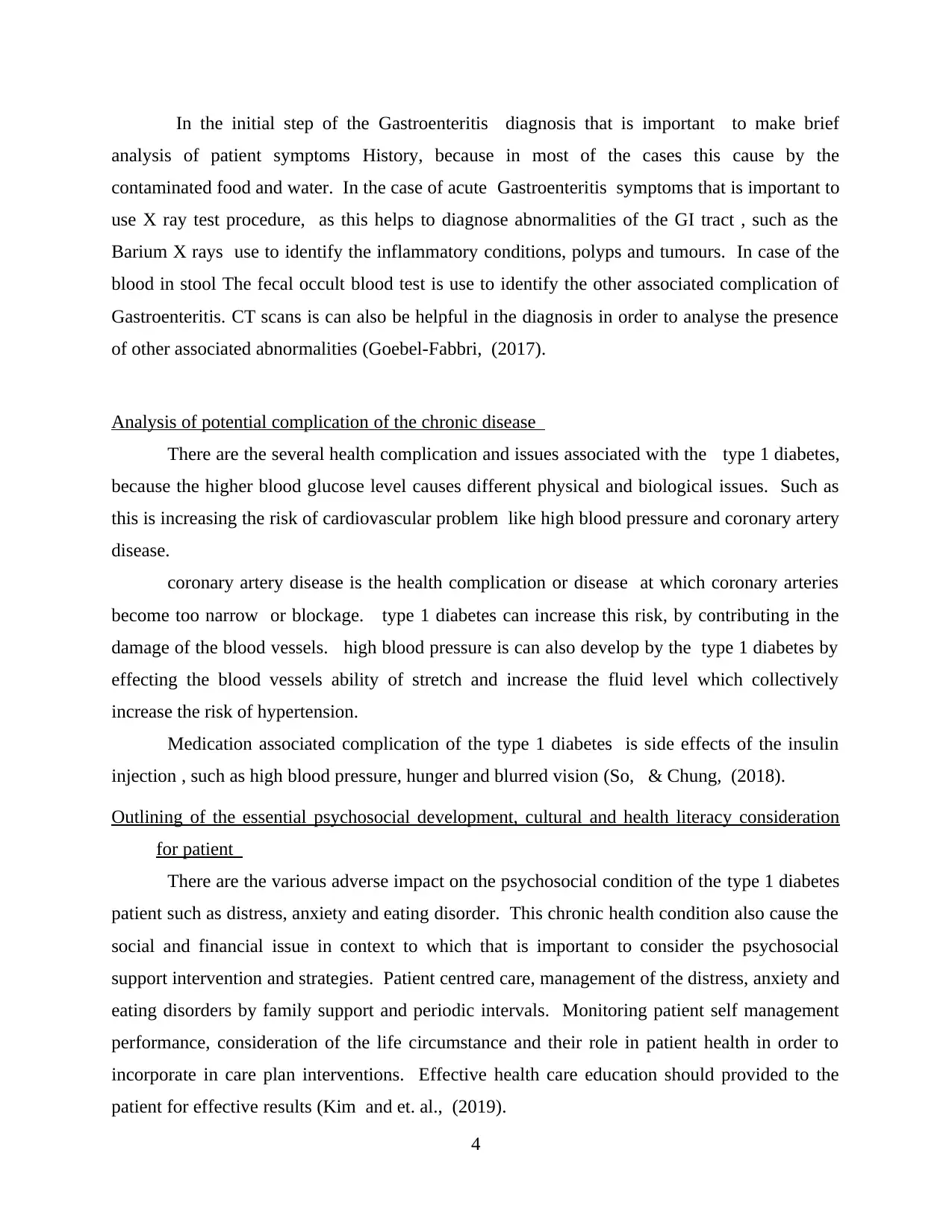
In the initial step of the Gastroenteritis diagnosis that is important to make brief
analysis of patient symptoms History, because in most of the cases this cause by the
contaminated food and water. In the case of acute Gastroenteritis symptoms that is important to
use X ray test procedure, as this helps to diagnose abnormalities of the GI tract , such as the
Barium X rays use to identify the inflammatory conditions, polyps and tumours. In case of the
blood in stool The fecal occult blood test is use to identify the other associated complication of
Gastroenteritis. CT scans is can also be helpful in the diagnosis in order to analyse the presence
of other associated abnormalities (Goebel-Fabbri, (2017).
Analysis of potential complication of the chronic disease
There are the several health complication and issues associated with the type 1 diabetes,
because the higher blood glucose level causes different physical and biological issues. Such as
this is increasing the risk of cardiovascular problem like high blood pressure and coronary artery
disease.
coronary artery disease is the health complication or disease at which coronary arteries
become too narrow or blockage. type 1 diabetes can increase this risk, by contributing in the
damage of the blood vessels. high blood pressure is can also develop by the type 1 diabetes by
effecting the blood vessels ability of stretch and increase the fluid level which collectively
increase the risk of hypertension.
Medication associated complication of the type 1 diabetes is side effects of the insulin
injection , such as high blood pressure, hunger and blurred vision (So, & Chung, (2018).
Outlining of the essential psychosocial development, cultural and health literacy consideration
for patient
There are the various adverse impact on the psychosocial condition of the type 1 diabetes
patient such as distress, anxiety and eating disorder. This chronic health condition also cause the
social and financial issue in context to which that is important to consider the psychosocial
support intervention and strategies. Patient centred care, management of the distress, anxiety and
eating disorders by family support and periodic intervals. Monitoring patient self management
performance, consideration of the life circumstance and their role in patient health in order to
incorporate in care plan interventions. Effective health care education should provided to the
patient for effective results (Kim and et. al., (2019).
4
analysis of patient symptoms History, because in most of the cases this cause by the
contaminated food and water. In the case of acute Gastroenteritis symptoms that is important to
use X ray test procedure, as this helps to diagnose abnormalities of the GI tract , such as the
Barium X rays use to identify the inflammatory conditions, polyps and tumours. In case of the
blood in stool The fecal occult blood test is use to identify the other associated complication of
Gastroenteritis. CT scans is can also be helpful in the diagnosis in order to analyse the presence
of other associated abnormalities (Goebel-Fabbri, (2017).
Analysis of potential complication of the chronic disease
There are the several health complication and issues associated with the type 1 diabetes,
because the higher blood glucose level causes different physical and biological issues. Such as
this is increasing the risk of cardiovascular problem like high blood pressure and coronary artery
disease.
coronary artery disease is the health complication or disease at which coronary arteries
become too narrow or blockage. type 1 diabetes can increase this risk, by contributing in the
damage of the blood vessels. high blood pressure is can also develop by the type 1 diabetes by
effecting the blood vessels ability of stretch and increase the fluid level which collectively
increase the risk of hypertension.
Medication associated complication of the type 1 diabetes is side effects of the insulin
injection , such as high blood pressure, hunger and blurred vision (So, & Chung, (2018).
Outlining of the essential psychosocial development, cultural and health literacy consideration
for patient
There are the various adverse impact on the psychosocial condition of the type 1 diabetes
patient such as distress, anxiety and eating disorder. This chronic health condition also cause the
social and financial issue in context to which that is important to consider the psychosocial
support intervention and strategies. Patient centred care, management of the distress, anxiety and
eating disorders by family support and periodic intervals. Monitoring patient self management
performance, consideration of the life circumstance and their role in patient health in order to
incorporate in care plan interventions. Effective health care education should provided to the
patient for effective results (Kim and et. al., (2019).
4
⊘ This is a preview!⊘
Do you want full access?
Subscribe today to unlock all pages.

Trusted by 1+ million students worldwide

Evaluation and illustration of nursing management priorities for the patient's condition
Nursing management prioritise in case of the type 1 diabetes chronic condition are
holistic care with the management of adequate nutrition, infection prevention , monitoring and
regulation of blood glucose level.
In context to the patient care and health condition management in case of type 1 diabetes
Pharmacological management priority is life long insulin therapy , this can be short and long
acting insulin.
Non-pharmacological management priorities in context to type 1 diabetes is weight loss,
body workout and low calories site. Self-management priorities are regular blood sugar
monitoring, health eating, taking medication, managing stress, health life routine such as work
out and exercise (Shalitin and et. al., (2018).
CONCLUSION
From the above study it has been concluded that in patient health care provisions
assessment and development of the effective health condition plan and essay is important, which
can further help to provide best and supportive patient information resources with all essential
information of the medical and self care.
5
Nursing management prioritise in case of the type 1 diabetes chronic condition are
holistic care with the management of adequate nutrition, infection prevention , monitoring and
regulation of blood glucose level.
In context to the patient care and health condition management in case of type 1 diabetes
Pharmacological management priority is life long insulin therapy , this can be short and long
acting insulin.
Non-pharmacological management priorities in context to type 1 diabetes is weight loss,
body workout and low calories site. Self-management priorities are regular blood sugar
monitoring, health eating, taking medication, managing stress, health life routine such as work
out and exercise (Shalitin and et. al., (2018).
CONCLUSION
From the above study it has been concluded that in patient health care provisions
assessment and development of the effective health condition plan and essay is important, which
can further help to provide best and supportive patient information resources with all essential
information of the medical and self care.
5
Paraphrase This Document
Need a fresh take? Get an instant paraphrase of this document with our AI Paraphraser

PART B
Type 1 diabetes is the chronic health condition at which patient face various health issues
and symptoms. This is the disease at which patient body stop processing blood glucose and lead
to the higher blood glucose level.
Pathophysiology of the Type 1 diabetes is involving the autoimmune destruction of the
pancreas beta cell. Due to which the important function of the beta cells, such as the
transmission of the blood glucose in to body cells for breakdown into the energy get inhibited.
And in this way it lead to the higher blood glucose, which further causes the adverse issues and
symptoms.
Symptoms of Type 1 diabetes are bed wetting, hungriness, weight loss, irritation,
fatigue and weakness, blurred vision , higher urination. There are the further more health issues
and complications associated with this chronic condition such as Gastroenteritis, cardiovascular
health issue and nerve damage. So in context to the management of this condition and prvention
of the other complication that is important to adopt health live style because that is one of the
most effective intervention.
6
Type 1 diabetes is the chronic health condition at which patient face various health issues
and symptoms. This is the disease at which patient body stop processing blood glucose and lead
to the higher blood glucose level.
Pathophysiology of the Type 1 diabetes is involving the autoimmune destruction of the
pancreas beta cell. Due to which the important function of the beta cells, such as the
transmission of the blood glucose in to body cells for breakdown into the energy get inhibited.
And in this way it lead to the higher blood glucose, which further causes the adverse issues and
symptoms.
Symptoms of Type 1 diabetes are bed wetting, hungriness, weight loss, irritation,
fatigue and weakness, blurred vision , higher urination. There are the further more health issues
and complications associated with this chronic condition such as Gastroenteritis, cardiovascular
health issue and nerve damage. So in context to the management of this condition and prvention
of the other complication that is important to adopt health live style because that is one of the
most effective intervention.
6

Patient have to go through different test and treatments within process of Type 1 diabetes
management such as Diagnostic test for the Type 1 diabetes is Blood sugar test and glycated
hemoglobin test. Which is essential to take in order to plan appropriate care. Treatment for the
Type 1 diabetes is healthy life style, low calories diet, weight loss, exercise and insulin therapy.
Medication are insulin injection, such as short acting, rapid acting, intermediated acting and long
acting insulin.
For Clara Type 1 diabetes Management strategies are healthy and lower calories diet,
regular work out, stress management with games and family activities. Regular blood sugar test
and regulation with insulin injection. Patient should take insulin according to the prescription,
self monitor the blood glucose level and engage in the health workout. Patient have to change
their complete life style with health activities and factors. Through which they can control their
blood glucose level and maintain the diabetes distress.
Associational resources for patient and their family education regarding health
conditions
(https://www.diabetesaustralia.com.au/living-with-diabetes/managing-your-
diabetes/managing-type-1/)
(https://www.mayoclinic.org/diseases-conditions/type-1-diabetes/diagnosis-
treatment/drc-20353017)
7
management such as Diagnostic test for the Type 1 diabetes is Blood sugar test and glycated
hemoglobin test. Which is essential to take in order to plan appropriate care. Treatment for the
Type 1 diabetes is healthy life style, low calories diet, weight loss, exercise and insulin therapy.
Medication are insulin injection, such as short acting, rapid acting, intermediated acting and long
acting insulin.
For Clara Type 1 diabetes Management strategies are healthy and lower calories diet,
regular work out, stress management with games and family activities. Regular blood sugar test
and regulation with insulin injection. Patient should take insulin according to the prescription,
self monitor the blood glucose level and engage in the health workout. Patient have to change
their complete life style with health activities and factors. Through which they can control their
blood glucose level and maintain the diabetes distress.
Associational resources for patient and their family education regarding health
conditions
(https://www.diabetesaustralia.com.au/living-with-diabetes/managing-your-
diabetes/managing-type-1/)
(https://www.mayoclinic.org/diseases-conditions/type-1-diabetes/diagnosis-
treatment/drc-20353017)
7
⊘ This is a preview!⊘
Do you want full access?
Subscribe today to unlock all pages.

Trusted by 1+ million students worldwide

REFERENCES
Books and Journals
Hirsch, M., and et. al., (2017). Googling endometriosis: a systematic review of information
available on the Internet. American journal of obstetrics and gynecology, 216(5), 451-458.
Bayles, K., McCullough, K., & Tomoeda, C. K. (2018). Cognitive-communication disorders of
MCI and dementia: Definition, assessment, and clinical management. Plural Publishing.
Boyde, M., and et. al., (2018). Self-care educational intervention to reduce hospitalisations in
heart failure: a randomised controlled trial. European Journal of Cardiovascular Nursing,
17(2), 178-185.
Dhaliwal, R., and et. al., (2018). Determinants of fracture in adults with type 1 diabetes in the
USA: results from the T1D Exchange Clinic Registry. Journal of Diabetes and its
Complications, 32(11), 1006-1011.
Goebel-Fabbri, A. (2017). Prevention and recovery from eating disorders in type 1 diabetes:
injecting Hope. Taylor & Francis.
So, C. F., & Chung, J. W. (2018). Telehealth for diabetes self-management in primary
healthcare: a systematic review and meta-analysis. Journal of telemedicine and telecare,
24(5), 356-364.
Kim, H. S., and et. al., (2019). Effects of community-based primary care management on
patients with hypertension and diabetes. Asia Pacific Journal of Public Health, 31(6), 522-
535.
Shalitin, S., and et. al., (2018). Impact of childhood type 1 diabetes on maternal work-family
relations. Journal of Pediatric Endocrinology and Metabolism, 31(5), 569-576.
Partridge, S. R., and et. al., (2018). Facebook groups for the management of chronic diseases.
Journal of medical Internet research, 20(1), e21.
8
Books and Journals
Hirsch, M., and et. al., (2017). Googling endometriosis: a systematic review of information
available on the Internet. American journal of obstetrics and gynecology, 216(5), 451-458.
Bayles, K., McCullough, K., & Tomoeda, C. K. (2018). Cognitive-communication disorders of
MCI and dementia: Definition, assessment, and clinical management. Plural Publishing.
Boyde, M., and et. al., (2018). Self-care educational intervention to reduce hospitalisations in
heart failure: a randomised controlled trial. European Journal of Cardiovascular Nursing,
17(2), 178-185.
Dhaliwal, R., and et. al., (2018). Determinants of fracture in adults with type 1 diabetes in the
USA: results from the T1D Exchange Clinic Registry. Journal of Diabetes and its
Complications, 32(11), 1006-1011.
Goebel-Fabbri, A. (2017). Prevention and recovery from eating disorders in type 1 diabetes:
injecting Hope. Taylor & Francis.
So, C. F., & Chung, J. W. (2018). Telehealth for diabetes self-management in primary
healthcare: a systematic review and meta-analysis. Journal of telemedicine and telecare,
24(5), 356-364.
Kim, H. S., and et. al., (2019). Effects of community-based primary care management on
patients with hypertension and diabetes. Asia Pacific Journal of Public Health, 31(6), 522-
535.
Shalitin, S., and et. al., (2018). Impact of childhood type 1 diabetes on maternal work-family
relations. Journal of Pediatric Endocrinology and Metabolism, 31(5), 569-576.
Partridge, S. R., and et. al., (2018). Facebook groups for the management of chronic diseases.
Journal of medical Internet research, 20(1), e21.
8
Paraphrase This Document
Need a fresh take? Get an instant paraphrase of this document with our AI Paraphraser

9
1 out of 11
Related Documents
Your All-in-One AI-Powered Toolkit for Academic Success.
+13062052269
info@desklib.com
Available 24*7 on WhatsApp / Email
![[object Object]](/_next/static/media/star-bottom.7253800d.svg)
Unlock your academic potential
Copyright © 2020–2025 A2Z Services. All Rights Reserved. Developed and managed by ZUCOL.




